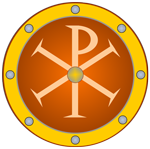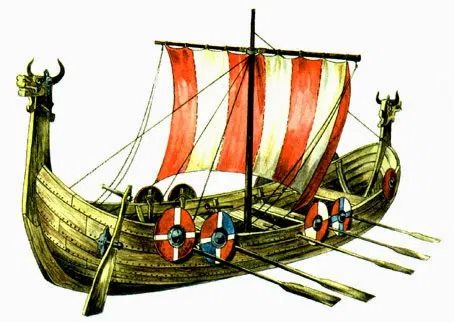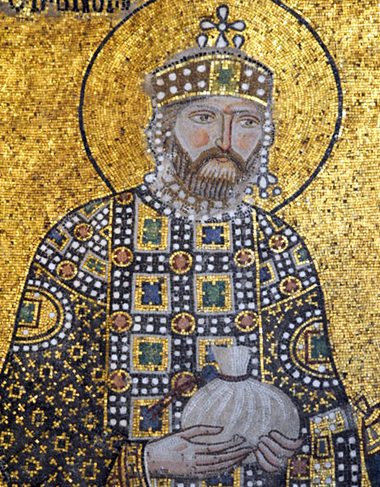
Battle of Pharos(Raid of the Rus) |
year: 1043July 1043 |
| A large scale invasion of the Rus who were crashed by the Byzantines at sea and on land | ★ ★ ★ ★ ★ |
|
enemy: Rus
|
location: At Pharos (now, “Rumeli Feneri”) the northernmost tip of the European coast of Bosporus before the exit to the Black Sea
|
accuracy:
●●●●●
|
|
battle type: Naval Battle |
war: Byzantine-Rus Wars |
modern country:
Turkey |
| ▼ The Byzantines(emperor: Constantine IX Monomachos) | ▼ The Enemies | |
| Commander: | Emperor Constantine IX | Prince of Novgorod Vladimir |
| Forces: | 100,000 men | |
| Losses: | 24 ships and their crew | at least 20,000, 100 ships |
| Background story: |
| The Rus of Kiev were a large and warlike nation and at times caused problems in Byzantium, though not as seriously as other neighboring peoples. The Rus were predominantly Slavic in population, but the ruling class and the warriors were Vikings, whom the Byzantines called Varangians. In the previous centuries they had made at least 3 very serious and eventful raids on Constantinople, while they had also attacked other parts of the empire (mainly on the shores of the Black Sea). From 1019 to 1055, the Russian ruler was Yaroslav I the Wise, the first to receive the title of tsar. Yaroslav was a capable ruler and sought good relations with Byzantium. Nevertheless, in 1024/1025, during his reign, an incident occurred after a long time, when a group of Rus under Chrysocheir invaded the Roman territory and reached as far as the island of Lemnos in North Agean, where they were annihilated. The next raid took place in 1043, and this time it was much more serious. The cause of the new attack was allegedly the murder of a Russian merchant during a quarrel in the market of Constantinople. This is hard to believe. Most likely, the killing of the merchant was just a pretext and the Russians simply wanted to launch a profitable raid taking advantage of the power vacuum that was created in Byzantium in the previous years, when a series of strange personalities ascended the throne. The current emperor (and Zoe's last husband) Constantine IX Monomachos had been crowned last year with no experience in war. In addition, he had serious problems with the military, who did not want him, so he tried to weaken them, thus weakening the military power of Byzantium. The Rus knew all this well because of their trade relations with Byzantium. After all, in previous raids it had been proven that they had good information in advance about the defensive situation of Constantinople.  When the Emperor was informed of the approach of this hostile huge force, he sent envoys to the Rus offering rich compensation. But the ambassadors were dismissed with threats and insults. The Byzantines had no choice but to prepare for war. At first, the Russian merchants in the capital were transfered inland. Also, the capable Katakalon Kekaumenos was appointed governor in the Danube regions, having the responsibility of guarding the western coast of the Black Sea. Since the fleet was not available, the emperor mobilized some merchant and decommissioned ships which were rigged, armed and equipped with Greek fire throwers. (This story with the armament of old ships is reported in previous Rus raids as well, and that means that maybe the sources are confused about the actual time of this events.) In July 1043 the Rus ships approached and anchored at the northern end of the European shore of the Bosphorus, just before the exit to the Black Sea. The location was called Pharos (meaning “lighthouse”, currently “Rumeli Fenari”), due to an ancient lighthouse that dominated the port from a hill above. According to Russian chroniclers, the Russians were convinced that it would be easy to capture Constantinople. That was their objective. Which explains why they were adamant and unequivocally rejected a diplomatic solution that would bring them a lot of gold. |
The Battle: |
 Constantine IX Monomachos The Byzantines, moving during the night, arrived at Pharos at dawn. The two fleets were lined up facing each other. For a few hours nothing happened. Neither side took the initiative to attack. The Rus had a bad experience against the Greek fire of the Byzantines, while they were probably surprised that they were forced to fight at this location. On the other hand, the Byzantines were hesitant (and perhaps frightened) in the face of the huge number and dense formation of the enemy ships. The overcast and the impending storm also contributed to this general reluctance to engage in battle. The emperor was watching from a coastal hill. Seeing that nothing was happening, he made one last effort for a compromise (in other words, to pay the Rus to leave). So he sent a delegation again to them. But the Rus remained unconvinced and foolishly demanded 3 liters of gold for each warrior (one liter or pound corresponded to 72 gold coins). The demand was outrageous and left no room for discussion. After that, the Emperor, enraged by the audacity of the Rus, ordered magistros Basil Theodorokanos to approach the Rus with three dromons and launch some shots in order to break their lines and force them to open up and fight. Theodorokanos did something more: He attacked and penetrated deep into the enemy formation. His ships were surrounded by the smaller Russian ships. For a moment it seemed that the dromons were trapped, but then the Byzantines started using the catapults and throwing Greek fire. Three Russian ships sank on the spot, seven were set on fire and one was captured when Theodorokanos himself jumped on the deck scattering the Rus on it. This fast success, and in fact with only three ships, disorganized the Rus who began to retreat, and when the rest of the Byzantine fleet entered the battle, they abandoned their formation and began to flee to the Black Sea. Many of them were trapped between the Byzantine fleet and the rocky shore. And then the storm broke out. A strong east wind was blowing the Russian ships on the reefs and rocks, while the Byzantines were showering with Greek fire taking advantage of the favorable wind. In this mayhem, those of the Rus who escaped the fire and drowning, tried to get to the shore where the Byzantine soldiers were waiting and cutting them. It is estimated that 100 Russian ships were destroyed that day. At least 15.00 were the dead. For many days afterwards, the corpses of the Rus were washed on the shores of the Bosphorus. Emperor Constantine IX stayed in the area for two days and then returned victorious to Constantinople. He left behind two battalions led by Theodorokanos and the parakoimomenos Nikolaos, with a mission to monitor the entrance of the strait. The whole fleet also remained there. The Russian fleet was able to save many of their own from the sea and the coast. Among them was their leader, Prince Vladimir. After the catastrophe, there was no way they could continue their operation against Constantinople. The only option was to go back. But there was a problem. There was no room for all in the remaining ships. So a unit of 6,000 men landed on the Thracian coast to return on foot. Their leader was Voivode Vyshata. The Byzantines had the bad idea to go after the Russian fleet. A relatively small squadron of 24 ships chased them. Their leader was admiral Konstantinos Kavallourios. The Russians, seeing the small size of the flotilla behind them, found a way to get some of their blood back: When the Byzantines, exhausted from rowing, anchored in a bay for the night, the Rus trapped them and attacked. 20 of these ships were destroyed and 4 were captured. Almost no one escaped from the crew and those taken prisoner were slaughtered. Meanwhile, the force of the 6,000 Rus marching north towards their country met the forces of general Kekaumenos in Varna, Bulgaria, and most were killed. 800 of them were captured and sent to Constantinople along with their leader Vyshata. According to Russian chroniclers, the 800 prisoners were all blinded. Byzantine historians do not mention anything about blinding, while in other cases they are not ashamed to mention such incidents. So the blinding probably didn’t happen. On their way back, the Russian fleet attacked Byzantine Crimea, and (perhaps) captured the city of Chersonesos. |
Noteworthy: |
| It is probable that Harald Hardrada (later Harald III of Norway) also participated in the campaign of the Rus. Harald had served in the Varangian Guard where he distinguished himself and became its commander. He was a friend of prince Vladimir and kept the gold he earned from Byzantium in Novgorod. In 1043 the Byzantines fired him and he took refuge in Novgorod. So his participation in the campaign is a reasonable guess, although it is not mentioned in the sources of the time. |
Aftermath: |
| After 3 years, peace was agreed with the Russians and prisoners were exchanged. The peace was sealed with the marriage of the son of the tsar Vsevolod I with Anastasia Skleraina, daughter of the emperor Constantine IX from his first marriage. Their son Vladimir II Monomachos was the most important tsar of the Kievan Rus. The Rus did not cause any problems in Byzantium again as dynastic disputes and civil wars broke out that lasted for centuries. |
|
|
